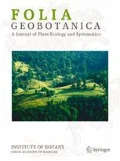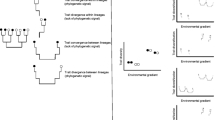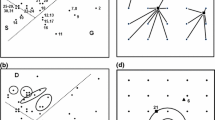Abstract
There is considerable uncertainty about if, and when, phylogenetic information is needed to answer various ecological questions about trait-based ecological studies. It has been recommended that both functional and phylogenetic information should be combined, and some researchers have even suggested that functional information for species should be ‘corrected’ because species are not phylogenetically independent. Here, we address these issues by identifying key types of questions in functional trait-based ecology and discussing the utility of phylogenetic information for answering them, either as a correction or in combination with functional traits. Phylogenetic analyses are identified as essential to answer questions related to the evolution of adaptations to abiotic and biotic conditions. However, we argue that phylogenetic information is not always relevant for functional trait studies, and should not be incorporated into ecological analyses without clear justification. Phylogenetic relatedness between species should not be considered a bias to be corrected, but rather an evolutionary signal that allows results to be interpreted at different evolutionary scales. Furthermore, if traits are conserved, phylogeny can be used as a proxy for missing information on traits and functional trait diversity. We conclude by providing guidelines on when to apply, and how to interpret, results obtained using phylogenetic information for a variety of ecological questions linked to functional traits.

Similar content being viewed by others
References
Ackerly DD, Knight CA, Weiss SB, Barton K, Starmer KP (2002) Leaf size, specific leaf area and microhabitat distribution of chaparral woody plants: contrasting patterns in species level and community level analyses. Oecologia 130: 449–457
Blomberg SP, Garland T (2002) Tempo and mode in evolution: phylogenetic inertia, adaptation and comparative methods. J Evol Biol 15: 899–910
Cadotte MW, Dinnage R, Tilman D (2012) Phylogenetic diversity promotes ecosystem stability. Ecology 93: S223–S233
Cadotte M, Albert CH, Walker SC (2013) The ecology of differences: assessing community assembly with trait and evolutionary distances. Ecol Lett 16: 1234–1244
Cavender-Bares J, Kozak KH, Fine PVA, Kembel SW (2009) The merging of community ecology and phylogenetic biology. Ecol Lett 12: 693–715
de Bello F, Lepš J, Sebastia MT (2005) Predictive value of plant traits to grazing along a climatic gradient in the Mediterranean. J Appl Ecol 42: 824–833
de Bello F, Lavorel S, Díaz S, Harrington R, Cornelissen JHC, Bardgett RD, Berg MP, Cipriotti P, Feld CK, Hering D, da Silva PM, Potts SG, Sandin L, Sousa JP, Storkey J, Wardle DA, Harrison PA (2010) Towards an assessment of multiple ecosystem processes and services via functional traits. Biodivers & Conserv 19: 2873–2893
Díaz S, Purvis A, Cornelissen JHC, Mace GM, Donoghue MJ, Ewers RM, Jordano PPearse WD (2013) Functional traits, the phylogeny of function, and ecosystem service vulnerability. Ecol & Evol 3: 2958–2975
Diniz-Filho JAF, Bini LM, Hawkins BA (2003) Spatial autocorrelation and red herrings in geographical ecology. Global Ecol Biogeogr 12: 53–64
Diniz-Filho JAF, Rodríguez MA, Bini, LM, Olalla-Tárraga MA, Cardillo M, Nabout JC, Hortal J, Hawkins BA (2009) Climate history, human impacts and global body size of Carnivora (Mammalia: Eutheria) at multiple evolutionary scales. J Biogeogr 36: 2222–2236
Diniz-Filho JAF, Bini LM, Rangel TF, Morales-Castilla I, Olalla-Tarraga MA, Rodriguez MA, Hawkins BA (2012) On the selection of phylogenetic eigenvectors for ecological analyses. Ecography 35: 239–249
Gerhold P, Cahill JF, Winter M, Bartish IV, Prinzing A (2015) Phylogenetic patterns are not proxies of community assembly mechanisms (they are far better). Funct Ecol 29: 600–614
Götzenberger L, de Bello F, Brathen KA, Davison J, Dubuis A, Guisan A, Leps J, Lindborg R, Moora M, Pärtel M, Pellissier L, Pottier J, Vittoz P, Zobel K, Zobel M (2012) Ecological assembly rules in plant communities-approaches, patterns and prospects. Biol Rev (Cambridge) 87: 111–127
Hoffmann WA, Franco AC (2009) The importance of evolutionary history in studies of plant physiological ecology: examples from cerrados and forests of central Brazil. Brazil J Pl Physiol 20:247–256
Hooper DU, Chapin FS, Ewel JJ, Hector A, Inchausti P, Lavorel S, Lawton JH, Lodge DM, Loreau M, Naeem S, Schmid B, Setala H, Symstad AJ, Vandermeer J, Wardle DA (2005) Effects of biodiversity on ecosystem functioning: A consensus of current knowledge. Ecol Monogr 75: 3–35
Kleyer M, Dray S, de Bello F, Lepš J, Pakeman RJ, Strauss B, Thuiller W, Lavorel S (2012) Assessing species and community functional responses to environmental gradients: which multivariate methods? J Veg Sci 23: 805–821
Klimeš L (2008) Clonar splitters and integrators in harsh environments of the Trans-Himalaya. Evol Ecol 22: 351–367
Lavorel S, Garnier E (2002) Predicting changes in community composition and ecosystem functioning from plant traits: revisiting the Holy Grail. Funct Ecol 16: 545–556
McGill BJ, Enquist BJ, Weiher E, Westoby M (2006) Rebuilding community ecology from functional traits. Trends Ecol Evol 21: 178–185
Münkemueller T, Boucher F, Thuiller W, Lavergne S (2015) Phylogenetic niche conservatism – common pitfalls and ways forward. Meth Ecol Evol 29: 627–639
Pavoine S, Bonsall MB (2011) Measuring biodiversity to explain community assembly: a unified approach. Biol Rev (Cambridge) 86: 792–812
Pavoine S, Vela E, Gachet S, de Belair, G, Bonsall MB (2011) Linking patterns in phylogeny, traits, abiotic variables and space: a novel approach to linking environmental filtering and plant community assembly. J Ecol 99: 165–175
Pavoine S, Gasc A, Bonsall MB, Mason NWH (2013) Correlations between phylogenetic and functional diversity: mathematical artefacts or true ecological and evolutionary processes? J Veg Sci 24: 781–793
Penone C, Davidson AD, Shoemaker KT, Di Marco M, Rondinini C, Brooks TM, Young, BE, Graham CH, Costa GC (2014). Inputation of missing data in life-history trait datasets: which approach performs the best? Meth Ecol Evol 5: 961–970
Pillar VD, Duarte LDS (2010) A framework for metacommunity analysis of phylogenetic structure. Ecol Letters 13: 587–596
Price T (1997) Correlated evolution and independent contrasts. Philos Trans, Ser B 352: 519–529
Prinzing A, Reiffers R, Braakhekke WG, Hennekens SM, Tackenberg O, Ozinga WA, Schaminee JHJ, van Groenendael JM (2008) Less lineages – more trait variation: phylogenetically clustered plant communities are functionally more diverse. Ecol Lett 11: 809–819
Silvertown J, Dodd M, Gowing D, Lawson C, McConway K (2006) Phylogeny and the hierarchical organization of plant diversity. Ecology 87: S39–S49
Soberón J (2007) Grinnellian and Eltonian niches and geographic distributions of species. Ecol Letters 10: 1115–1123
Swenson NG (2009) Phylogenetic Resolution and Quantifying the Phylogenetic Diversity and Dispersion of Communities. PloS ONE 4
Swenson NG (2011) Phylogenetic Beta Diversity Metrics, Trait Evolution and Inferring the Functional Beta Diversity of Communities. PloS ONE 6
Swenson NG, Enquist BJ (2009) Opposing assembly mechanisms in a Neotropical dry forest: implications for phylogenetic and functional community ecology. Ecology 90: 2161–2170
van der Putten WH, Vet LEM, Harvey JA, Wackers FL (2001) Linking above- and belowground multitrophic interactions of plants, herbivores, pathogens, and their antagonists. Trends Ecol Evol 16: 547–554
Violle C, Navas M-L, Vile D, Kazakou E, Fortunel C, Hummel I, Garnier E (2007) Let the concept of trait be functional! Oikos 116: 882–892
Webb CO, Ackerly DD, McPeek MA, Donoghue MJ (2002) Phylogenies and community ecology. Annual Rev Ecol Syst 33: 475–505
Westoby M (1998) A leaf-height-seed (LHS) plant ecology strategy scheme. Pl & Soil 199: 213–227
Westoby M, Leishman MR, Lord JM (1995) On missinterpreting the ‘phylogentic correction’. J Ecol 83: 531–534
Acknowledgements
We wish to thank Ana Malhado for her help with the logistics of the Maceió meeting. We thank also two reviewers for their constructive comments on the manuscript and for deciding to write a response paper (which we haven’t read at time of submitting our final draft) to this study. FdB is funded by the Czech Science Foundation, grant P505/12/1296. FdB was supported by Brazilian CAPES PVE grant number 88881.068053/2014-01. ATCD was supported by the the Brazilian BJT grant number A011/2013 (Bolsista CAPES/BRASIL). JH is supported by a Spanish DGCyT Ramón y Cajal grant and by the Brazilian CNPq PVE grant number 401471/2014-4. JAF Diniz-Filho and RJ Ladle receive CNPq Research Productivity fellowships. LG: European Union’s Seventh Framework Programme for research, technological development and demonstration under grant agreement no. GA-2010-267243 – PLANT FELLOWS; JL is funded by the Centre of Excellence PLADIAS, GACR-14-36079G.
Author information
Authors and Affiliations
Corresponding author
Rights and permissions
About this article
Cite this article
de Bello, F., Berg, M.P., Dias, A.T.C. et al. On the need for phylogenetic ‘corrections’ in functional trait-based approaches. Folia Geobot 50, 349–357 (2015). https://doi.org/10.1007/s12224-015-9228-6
Received:
Accepted:
Published:
Issue Date:
DOI: https://doi.org/10.1007/s12224-015-9228-6




